Sumter County
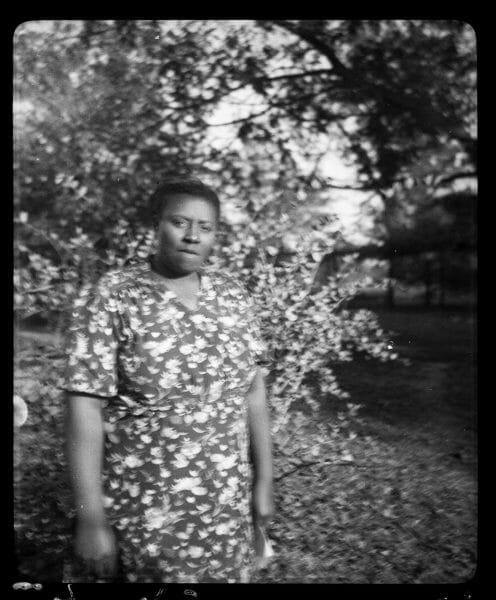 Adele “Vera” Hall
Home to one of the South’s oldest covered bridges, Sumter County is located in the west-central part of Alabama in the Black Belt region. Sumter was also the birthplace of Ruby Pickens Tartt, who helped to collect African American narratives and local musical traditions, and of Vera Hall Ward, a blues singer whom Tartt helped bring to fame. The county also was home to Julia S. Tutwiler, pioneer advocate of women’s education, prison reform, and women’s rights, and who wrote the state song. The county is governed by an elected six-member commission and includes the incorporated cities of Livingston and York.
Adele “Vera” Hall
Home to one of the South’s oldest covered bridges, Sumter County is located in the west-central part of Alabama in the Black Belt region. Sumter was also the birthplace of Ruby Pickens Tartt, who helped to collect African American narratives and local musical traditions, and of Vera Hall Ward, a blues singer whom Tartt helped bring to fame. The county also was home to Julia S. Tutwiler, pioneer advocate of women’s education, prison reform, and women’s rights, and who wrote the state song. The county is governed by an elected six-member commission and includes the incorporated cities of Livingston and York.
- Founding Date: December 18, 1832
- Area: 907 square miles
- Population: 12,595 (2020 Census estimate)
- Major Waterways: Tombigbee River
- Major Highways: Interstate 20/59, U.S. 11, U.S. 80
- County Seat: Livingston
- Largest City: Livingston
History
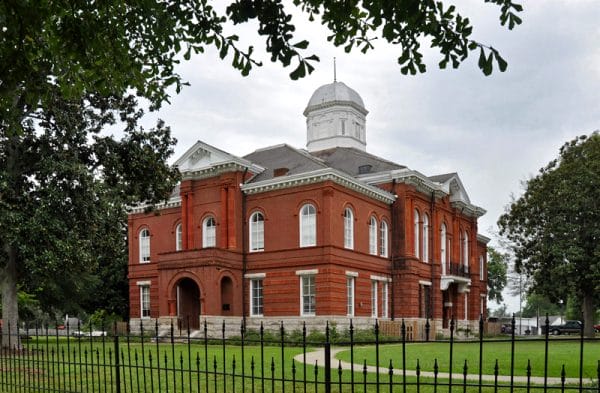 Sumter County Courthouse
Sumter County was created by the Alabama legislature on December 18, 1832, from former Choctaw Indian lands ceded to the United States in the Choctaw Treaty of 1830, also known as the Treaty of Dancing Rabbit Creek. Prior to its creation, Indian agent and future politician George Strother Gaines operated the Choctaw Trading House near present-day Epes. Sumter County was named in honor of Gen. Thomas Sumter of South Carolina, a Revolutionary War hero. The earliest settlers came to the county from the Carolinas, Georgia, Tennessee, and Virginia. Some of the first towns included Gaston, Gainesville, Paynesville, Bluffport, Warsaw, Tompkinsville, and Sumterville.
Sumter County Courthouse
Sumter County was created by the Alabama legislature on December 18, 1832, from former Choctaw Indian lands ceded to the United States in the Choctaw Treaty of 1830, also known as the Treaty of Dancing Rabbit Creek. Prior to its creation, Indian agent and future politician George Strother Gaines operated the Choctaw Trading House near present-day Epes. Sumter County was named in honor of Gen. Thomas Sumter of South Carolina, a Revolutionary War hero. The earliest settlers came to the county from the Carolinas, Georgia, Tennessee, and Virginia. Some of the first towns included Gaston, Gainesville, Paynesville, Bluffport, Warsaw, Tompkinsville, and Sumterville.
In 1832, Livingston became the county seat and remains so. The first courthouse was built of logs in 1833 and a second framed courthouse was built in 1839 on the same site and burned in 1901. In 1902, the third and present courthouse was built on the same site, a domed, brick structure that has undergone several renovations yet is still in use today.
Major Cities and Demographics
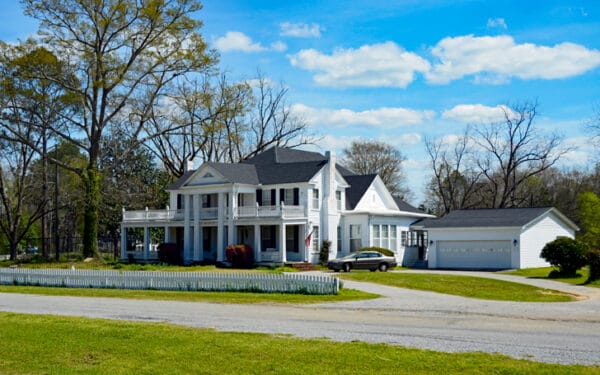 Dr. H. B. Ward House
According to 2020 Census estimates, the population of Sumter County was 12,595. Of that total, 71.4 percent of respondents identified themselves as African American, 25.3 percent as white, 2.0 percent as Asian, 1.2 percent as Hispanic, 1.0 percent as two or more races, and 0.1 percent as Native American. The county seat, Livingston, is the largest city in Sumter, with an estimated population of 3,286. Other significant population centers include York, Emelle, Cuba, Geiger, and Gainesville. The median household income was $26,150, compared with $ $52,035 for the state as a whole, and per capita income was $16,977, compared with $28,934for the state as a whole.
Dr. H. B. Ward House
According to 2020 Census estimates, the population of Sumter County was 12,595. Of that total, 71.4 percent of respondents identified themselves as African American, 25.3 percent as white, 2.0 percent as Asian, 1.2 percent as Hispanic, 1.0 percent as two or more races, and 0.1 percent as Native American. The county seat, Livingston, is the largest city in Sumter, with an estimated population of 3,286. Other significant population centers include York, Emelle, Cuba, Geiger, and Gainesville. The median household income was $26,150, compared with $ $52,035 for the state as a whole, and per capita income was $16,977, compared with $28,934for the state as a whole.
Economy
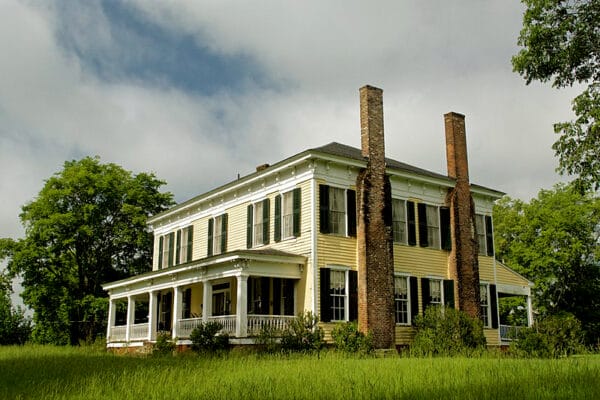 Oakhurst
As part of Alabama’s Black Belt, farming was the prevailing occupation in Sumter County until well into the twentieth century, with cotton, corn, and sweet potatoes the county’s main agricultural products. With easy access to the Tombigbee River, transportation of goods was also an important part of the county’s economy during the nineteenth and early twentieth centuries. Gainesville became the largest inland shipping port of cotton in the world by the late nineteenth century. After the damage caused by the boll weevil and the desperate years of the Great Depression, farmers tried diversifying crops, although with limited success. Sumter County, once so wealthy from cotton, struggled throughout the twentieth century. Today, cattle are the major agricultural product, and lumbering is the major industry.
Oakhurst
As part of Alabama’s Black Belt, farming was the prevailing occupation in Sumter County until well into the twentieth century, with cotton, corn, and sweet potatoes the county’s main agricultural products. With easy access to the Tombigbee River, transportation of goods was also an important part of the county’s economy during the nineteenth and early twentieth centuries. Gainesville became the largest inland shipping port of cotton in the world by the late nineteenth century. After the damage caused by the boll weevil and the desperate years of the Great Depression, farmers tried diversifying crops, although with limited success. Sumter County, once so wealthy from cotton, struggled throughout the twentieth century. Today, cattle are the major agricultural product, and lumbering is the major industry.
Employment
According to 2020 Census estimates, the workforce in Sumter County was divided among the following industrial categories:
- Educational services, and health care and social assistance (28.9 percent)
- Retail trade (16.1 percent)
- Manufacturing (13.2 percent)
- Arts, entertainment, recreation, and accommodation and food services (11.5 percent)
- Public administration (5.9 percent)
- Transportation and warehousing, and utilities (5.2 percent)
- Other services, except public administration (4.6 percent)
- Professional, scientific, management, and administrative and waste management services (3.6 percent)
- Finance and insurance, and real estate, rental, and leasing (3.4 percent)
- Construction (3.2 percent)
- Agriculture, forestry, fishing and hunting, and extractive (2.7 percent)
- Information (1.1 percent)
- Wholesale trade (0.8 percent)
Education
The Sumter County School System oversees seven primary and secondary schools. The University of West Alabama, formerly the Livingston Female Academy, is a traditional, four-year college located in Livingston that offers both undergraduate and graduate degree programs.
Geography
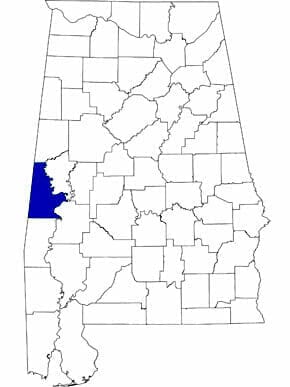 Sumter County Map
Encompassing more than 900 square miles, Sumter County is part of Alabama’s Black Belt and is part of the East Gulf Coastal Plain physiographic section that consists of rolling prairies and coastal plains. Oak forests grow along the shoreline of the Tombigbee River and its tributaries, whereas shortleaf pine forests dot the prairies. Sumter is bordered by Pickens County to the north, Greene and Marengo Counties to the east, Choctaw County to the south, and the state of Mississippi to the west.
Sumter County Map
Encompassing more than 900 square miles, Sumter County is part of Alabama’s Black Belt and is part of the East Gulf Coastal Plain physiographic section that consists of rolling prairies and coastal plains. Oak forests grow along the shoreline of the Tombigbee River and its tributaries, whereas shortleaf pine forests dot the prairies. Sumter is bordered by Pickens County to the north, Greene and Marengo Counties to the east, Choctaw County to the south, and the state of Mississippi to the west.
The Tombigbee River runs along Sumter County’s eastern border. The river is one of the most biologically diverse in the nation and is home to a number of at-risk species. A series of locks and dams, constructed beginning in the 1930s, along the Tombigbee River facilitate river traffic and also provide scenic views and recreational opportunities.
Interstate 20/59 is one of Sumter County’s main transportation routes. It runs from the southwest to the northeast. U.S. Highway 11 also runs from the southwest to the northeast; U.S. Highway 80 runs west to east across the southern half of Sumter County. There are no public airports in Sumter County.
Events and Places of Interest
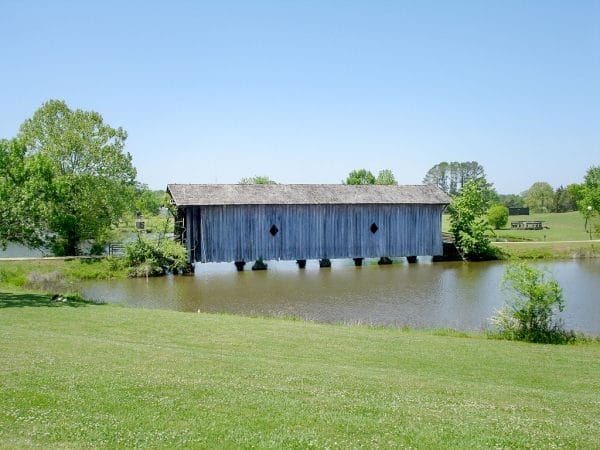 Alamuchee Covered Bridge
Cultural and recreational opportunities in Sumter County include the University of West Alabama’s Outdoor Sculpture Exhibition. Sculptures by contemporary artists are located throughout the campus, and new sculptures are added on a continuous basis. The campus of the University of West Alabama also serves as the site for the Alamuchee Covered Bridge. Capt. William A. C. Jones of Livingston designed and built the structure in 1861, making it one of the South’s oldest remaining covered bridges. Made of hand-hewn heart pine, the bridge originally spanned the Sucarnochee River. In 1924, the bridge was taken down and reconstructed across a creek on the old Bellamy-Livingston Road. It remained in use until 1958, when it was moved to its present location and restored in 1971. Also in Livingston is the historic Spence-Moon House, which was owned by Jones at one time and is listed on the Alabama Register of Landmarks and Heritage. The site of Fort Tombecbe, built by the French in 1736, is located near the town of Epes; artifacts from the site are on display at the Black Belt Museum on the campus of UWA.
Alamuchee Covered Bridge
Cultural and recreational opportunities in Sumter County include the University of West Alabama’s Outdoor Sculpture Exhibition. Sculptures by contemporary artists are located throughout the campus, and new sculptures are added on a continuous basis. The campus of the University of West Alabama also serves as the site for the Alamuchee Covered Bridge. Capt. William A. C. Jones of Livingston designed and built the structure in 1861, making it one of the South’s oldest remaining covered bridges. Made of hand-hewn heart pine, the bridge originally spanned the Sucarnochee River. In 1924, the bridge was taken down and reconstructed across a creek on the old Bellamy-Livingston Road. It remained in use until 1958, when it was moved to its present location and restored in 1971. Also in Livingston is the historic Spence-Moon House, which was owned by Jones at one time and is listed on the Alabama Register of Landmarks and Heritage. The site of Fort Tombecbe, built by the French in 1736, is located near the town of Epes; artifacts from the site are on display at the Black Belt Museum on the campus of UWA.
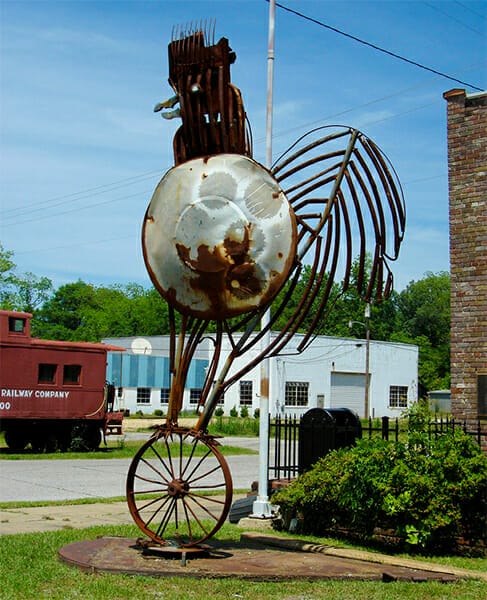 Coleman Center for the Arts
In the old town of Gainesville there are a number of historic cemeteries and churches. The First Presbyterian Church dates from 1837 and has been rescued from fire on three occasions—once with a hand-to-hand bucket brigade. Inside, visitors may see whale-oil lamps, box pews, the altar’s original chairs, and a bell made in part from 500 melted silver dollars. Several denominations share this church, thus labeling themselves “Metho-bap-terians.” Other interesting sites in Gainesville include the 1872 Methodist Church, St. Alban’s Episcopal Church founded in 1879, and a Confederate cemetery.
Coleman Center for the Arts
In the old town of Gainesville there are a number of historic cemeteries and churches. The First Presbyterian Church dates from 1837 and has been rescued from fire on three occasions—once with a hand-to-hand bucket brigade. Inside, visitors may see whale-oil lamps, box pews, the altar’s original chairs, and a bell made in part from 500 melted silver dollars. Several denominations share this church, thus labeling themselves “Metho-bap-terians.” Other interesting sites in Gainesville include the 1872 Methodist Church, St. Alban’s Episcopal Church founded in 1879, and a Confederate cemetery.
The Coleman Center for the Arts in York houses a small art museum. The museum, a library, genealogical room, and a cultural center occupy an early-twentieth-century store. Local citizens contributed the land, building, services, and funds for the center. In addition to its permanent collection, which includes an original etching by famed French Impressionist painter Pierre-August Renoir, the museum features traveling exhibits as well.
Further Reading
- The Heritage of Sumter County, Alabama. Clanton, Ala.: Heritage Publishing Consultants, 2005.



